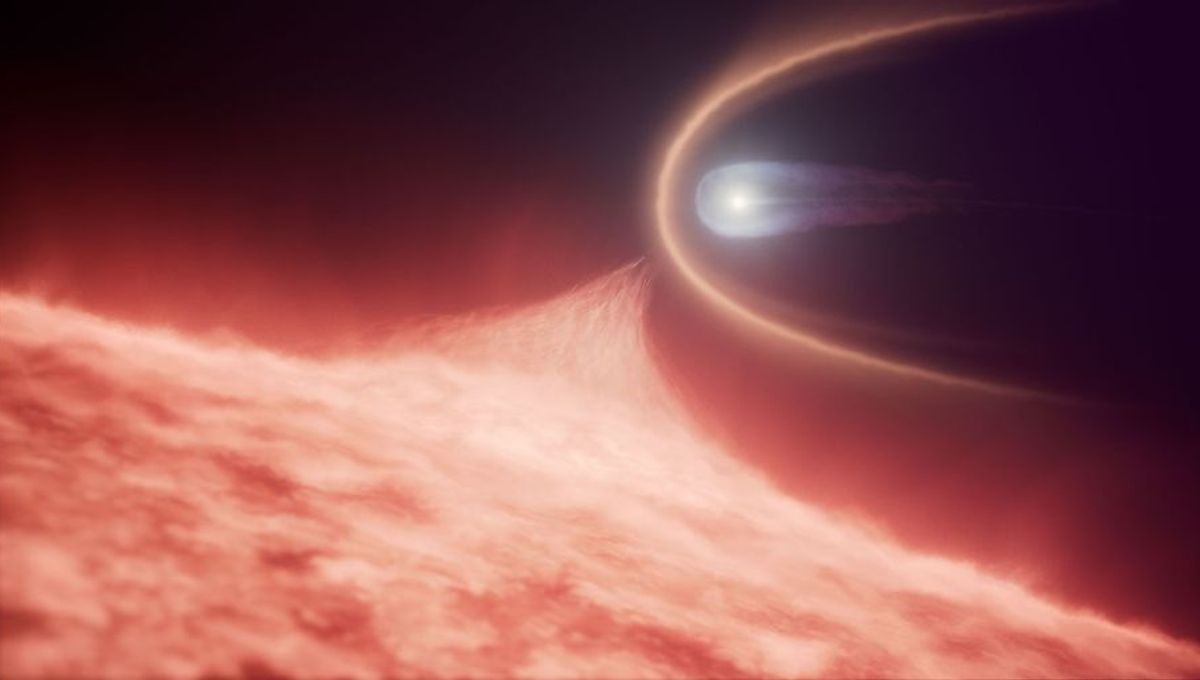
Astronomers report the finding of a unique new object that doesn’t fit with categories that were only established in the last few years. They have observed an ultra-massive white dwarf with an outer layer of hydrogen and helium, 10 billion times thinner than other white dwarfs. This object is believed to be the product of a past merger event. The name given to it is WD 0525+526.
White dwarfs are the end product of stars like our Sun or those that are up to a few times its mass. They are not heavy enough to go supernova, so once they finish burning the hydrogen in their core, they will swell up into red giants and fuse helium. Eventually, they will run out of helium to fuse too. Their outer layer will be mostly blown away, leaving a dense, contracted core, which is the white dwarf.
Most of these white dwarfs are about 60 percent of the mass of the Sun. They also tend to cool down with time, since their heat source is simply caused by the core collapse and not by any active process like fusion. But it is not like this for all white dwarfs. Recent observations from the Gaia spacecraft led to the realization that there are hot and old white dwarfs. The heat comes from the fact that the incredible density inside these objects creates a crystallization process, which releases heat.
Six of these hot, old, and very massive white dwarfs were of particular interest. Astronomers found evidence of carbon in their atmospheres, and given their masses – much higher than the average white dwarf (and larger than the Sun) – it was believed they were the product of merger events. But despite its size, WD 0525+526 doesn’t possess those carbon features seen in optical observations.
The hydrogen and helium layer is very thin, like 10 billion times thinner than what we expect.
Dr Snehalata Sahu
It’s thanks to the Hubble Telescope and its ultraviolet capabilities that researchers were able to find evidence of carbon. And, that this object too came from a merger event, but one that caused structural differences to the resulting ultra-massive white dwarf.
“We are not able to explain it with other scenarios,” co-lead author Dr Snehalata Sahu, from the University of Warwick, told IFLScience.
They believe that the white dwarf is not experiencing a full convection, so carbon cannot escape and be seen in optical observations, but there is a semi-convection below a very thin layer of hydrogen. And we really mean thin, everything considered!
“The hydrogen and helium layer is very thin, like 10 billion times thinner than what we expect. So it means some process would have taken that extra hydrogen helium,” Dr Sahu told IFLScience.
The researchers are not sure what collided with the original white dwarf to produce this object. Possibly it was a subgiant star, based on some of the leading simulations. But many uncertainties remain, so they were not ready to pick a scenario.
“We would like to extend our research on this topic by exploring how common carbon white dwarfs are among similar white dwarfs, and how many stellar mergers are hiding among the normal white dwarf family,” study co-leader Antoine Bedrad, also from the University of Warwick, said in a statement.
“That will be an important contribution to our understanding of white dwarf binaries, and the pathways to supernova explosions.”
The team wants to stress how they wouldn’t have found out about this object without ultraviolet observations. And they teased us that they are working on an analysis that involves white dwarfs and the remains of a planetary system that would have also been impossible without ultraviolet observations. There is currently only Hubble doing that kind of work, and it is an old telescope that has not been refurbished in 16 years. The next instrument, the Ultraviolet Explorer by NASA, won’t launch until 2030 at least.
“Hubble is going to die. We know that its instrument is coming to an end, so we have to think about the next generation UV telescopes,” Dr Sahu explained.
The study is published in the journal Nature Astronomy.
Correction (18/8/25): This story has been updated to correct an error in the quote from Dr Sahu. The hydrogen-helium layer was quoted as being 10 million times thinner than expected when in reality it is 10 billion times thinner. This has been corrected throughout the article.
Source Link: Unique White Dwarf Heavier Than The Sun Is Hiding A Merger In Its Past